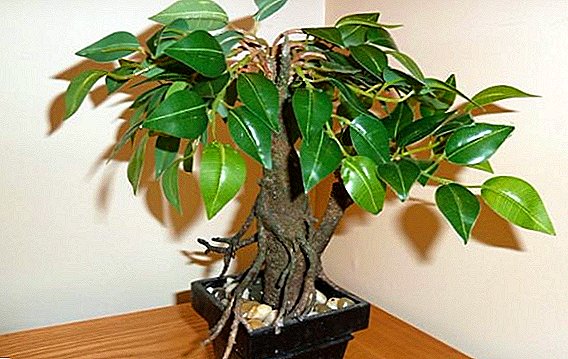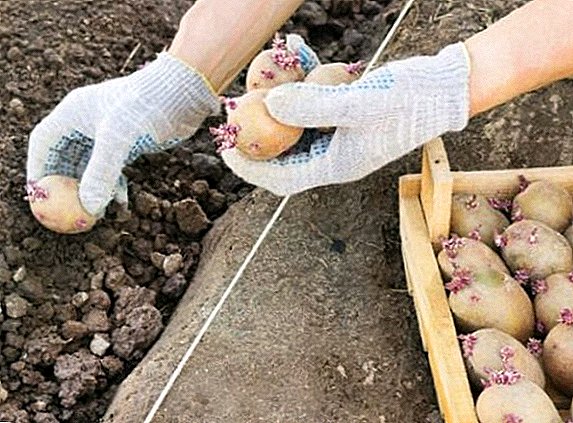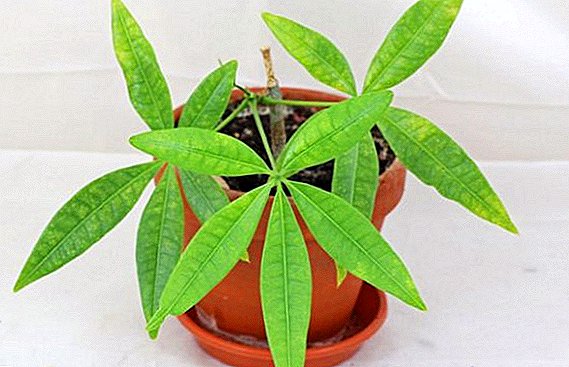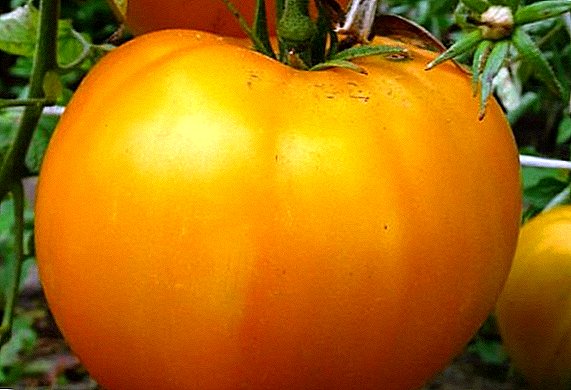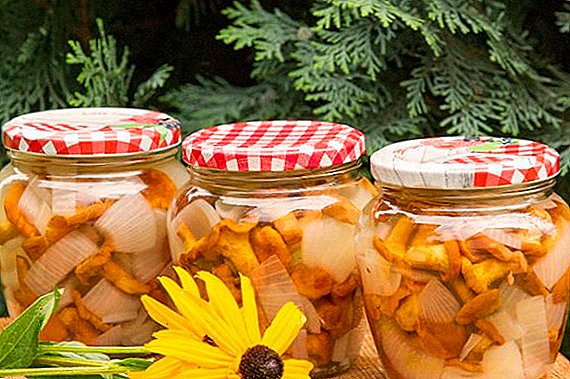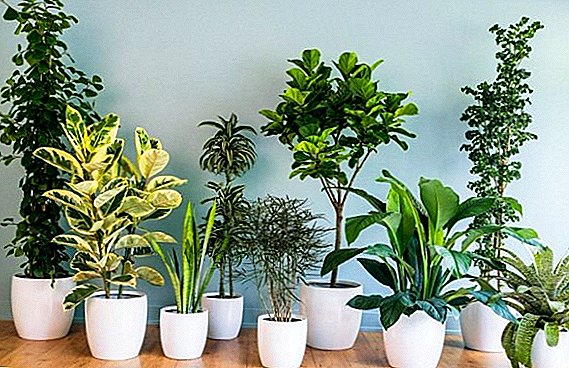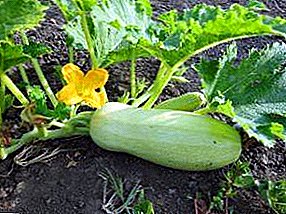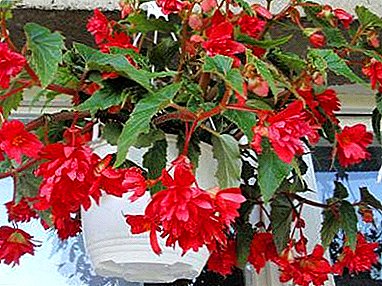
Ampelnaya begonia - very beautiful and bright plant. It looks spectacular in hanging pots or pots on a high leg, attracting the attention of almost any person. In addition, care for ampelous begonia does not require special skills. And even a novice amateur grower is subject to the reproduction of this flower in simple ways, which will be discussed in this article.
Amppella begonia is a type of tuberous begonia with powerful hanging stems about 30–40 cm long and with double and semi-double flowers of different colors (white, yellow, scarlet, pink, orange, etc.), large leaves can be glossy or have a fleece also have various colors (saturated green, emerald green, brownish with green veins).
What are the ways of breeding?
Ampel begonia multiplies in the following ways:
- Seeds.
- Leaf.
- Cuttings.
- Tubers.
- The division of the bush.
You can find more information about the breeding methods for tuberous begonia and its care here.
Reproduction at home
At home The most acceptable method of breeding ampelous begonia is grafting (vegetative method): this method is simple (even for beginners in floriculture), fast (the first flowers will bloom in August), while cutting, all signs of the mother plant (color, leaf color, shape and size of a flower, etc.) are preserved .
Growing from cuttings
Reproduction of ampelous begonia by cutting can be carried out throughout the year, but rooting will occur more quickly and effectively in spring.
- Preparation of cuttings.
 Chose a healthy, strong, without visible damage, non-flowering shoot length of 8-12 cm.
Chose a healthy, strong, without visible damage, non-flowering shoot length of 8-12 cm.- The shoot is cut from the bush of ampelous begonia below the node with sharp scissors or a knife. The cut is made slightly obliquely.
- Remove all lower leaves from the appendix. It should be at least 2 -3 kidneys.
- It is recommended to dry the petiole for several hours.
- Rooting.
Root ampelous begonia in two ways: in the water or in the ground.
- Rooting in water is recommended to be carried out in a small glass or plastic container, preferably of dark glass or plastic. The water level (you can use the usual separated or thawed) in the tank should be such that the lower part of the cuttings is in the water and the rest is above the water.
This condition is explained by the fact that the appearance of the roots requires oxygen. As a rule, the root system is formed on the handle just at the border of water and air in the tank. It is not recommended to immerse the sprout in water so that its tip touches the bottom of the dish: this may cause it to rot. The water in the vessel also should not be changed, but only topped up as it evaporates. It is also sometimes practiced to add activated carbon tablets to water for its disinfection and to add the drug "Kornevin".
The maximum number of shoots that can be placed in one container is 1–2: cuttings die more often in large masses. The vessel with the handle is placed in a warm place, but not under direct sunlight. You can cover all with a plastic bag to create greenhouse conditions. After the appearance of the roots of a length of 0.7 - 1.5 cm in length, the plant can be planted in the ground.
- Begonia rooted better in the soil. For these purposes, loose and nutritious soil is used: it can be ground bought from the store or mixed with one's own hands (peat and coarse sand in a 1: 1 ratio).
It is better to use a small transparent container as a rooting pot: it is easier to observe the development of the roots. It is possible to use ordinary plastic cups for these purposes, but do not forget to make drainage holes in them.
If there are many cuttings, rooting is done in special boxes or transparent plastic food containers: shoots are compact in such containers, which greatly facilitates maintenance. Cut and dried petiole is dipped into the water by a tip, and then - in “Kornevin”.
Further, at an angle of 45 degrees, the shoot is buried 2–3 cm in moist soil. Rooting will be more likely to succeed if the pot is placed on top with a can or plastic bag. With the advent of the first roots, "greenhouse" can be removed.
Attention! When covering the container with the handle of the package or other improvised means, it is important not to forget about airing!
In the created greenhouse conditions, excess condensate may contribute to the decay of cuttings. To avoid this, it is necessary to remove the film once a day for half an hour every day at a cool temperature, and at a high temperature - 3 times for 10 - 15 minutes.
The optimal conditions for the development of shoots are the following: temperature + 20 ° C - + 28 ° C, moderate watering, diffused sunlight, regular spraying.
- Rooting in water is recommended to be carried out in a small glass or plastic container, preferably of dark glass or plastic. The water level (you can use the usual separated or thawed) in the tank should be such that the lower part of the cuttings is in the water and the rest is above the water.
- Planting in the soil.
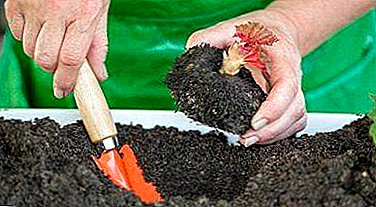 After the root system is formed in the cuttings, they need to be transplanted into individual pots. To do this, it is necessary to prepare a container in advance, fill its lower layer with expanded clay, and then - with a substrate from the store or with a mixture of peat and sand.
After the root system is formed in the cuttings, they need to be transplanted into individual pots. To do this, it is necessary to prepare a container in advance, fill its lower layer with expanded clay, and then - with a substrate from the store or with a mixture of peat and sand.- Having made a dimple in the ground with a hand, place the seedling in the pot, gently straightening its roots, if rooting was previously performed in water.
The best method of planting for young seedlings rooting in the ground is the method of transshipment: the plant comes from the tank and, without shaking off an earthy coma, is placed in a new pot.
- The top layer of soil at the stem is crushed by hands, the plant is watered and put in its place. On a pot with a diameter of 12 cm, it is recommended to plant 5 to 6 petioles so that the bush ampelous begonia is lush and beautiful.
We offer you a video on the preparation of cuttings and rooting:
The following video tutorial is about planting a young begonia plant:
How to grow from seed?
The breeding method of ampelous begonia with seeds is not as popular as grafting. This is explained by the fact that a new adult plant from a seed will not turn out soon.
- For this method of reproduction, you must first collect the seeds. After pollination of begonia flowers (natural or artificial), the plant in the fall forms a fruit in the form of a box (flower bag) that contains seeds.
- They are very small in size, for better visibility, they are mixed with sand before sowing.
- At the end of December - the beginning of January, the container is filled with soil (1 part of sheet soil: 1 part of sand: 2 parts of humus), seeds are sown on its wetted surface, which are not buried.
- Next, the box is covered with glass or plastic wrap, not forgetting about the daily ventilation of crops. After the shoots appear and get stronger, the coating can be removed.
- When seedlings form 2 - 3 leaves, it is necessary to perform a pick, spreading them 2 - 3 cm apart.
- A month or two later, a second picking is carried out: the distance between the seedlings should be 5-6 cm.
- And only in May, young shoots are planted in individual pots.
Care for young plants
 It is recommended to grow transplants of ampelous begonia transplanted into individual pots in a bright place, but without direct sunlight on the foliage. The ideal option is the north, north-west, northeast windows. A young plant is watered often, but little by little.
It is recommended to grow transplants of ampelous begonia transplanted into individual pots in a bright place, but without direct sunlight on the foliage. The ideal option is the north, north-west, northeast windows. A young plant is watered often, but little by little.- It is important not to allow excessive moisture in the substrate, otherwise the begonia will die from rotting.
- As the stems grow, a special support will be needed to support them. Top dressing is made by complex mineral fertilizers, bought in flower shops, from spring to autumn 1 - 2 times a month.
- After sowing seeds of ampelous begonia, the container is transferred to a warm bright place (+ 24С - + 28С), systematically the top layer of soil is sprayed from the spray gun with warm water.
- During the winter months, it is necessary to supplement the seedlings with phytolamps (read more about caring for tuberous begonia in the winter here).
- Two weeks after the first picking, the plants can be fed weekly with a poorly diluted solution of mineral fertilizers.
More detailed information about the care of the tuberous begonia at home and in the open field can be found in a separate article.
Possible problems
- Rot, powdery spots, etc. - characteristic infectious diseases of young ampelous begonia.
For the prevention of this phenomenon, it is recommended to disinfect the soil, the pot into which cuttings will be planted or seeds to be sown (fungicide treatment, heat treatment). You will find a description of diseases of the tuberous begonia that prevent the plant from blooming, as well as control and prevention measures in a separate article.
- Rotting cuttings. This phenomenon is possible with excessive irrigation and irrigation. Also, do not forget about the daily airing of "greenhouses", in which the rooting of the plant.
- Seeds do not germinate. This is possible if the seed was poor quality or lay for a long time. It is important to remember that the germination of seeds of the ampelous begonia is lost over time, so it is advisable to sow those seeds that were collected the previous day in the fall in the winter. And, of course, check the shelf life of seeds purchased in the store.
Propagation by cuttings and seeds are the two most popular ways of breeding ampelous begonia. Besides not requiring special cash investments. The main conditions for success in this - the desire of the grower, the creation of comfortable conditions and proper care for a young plant.


 Chose a healthy, strong, without visible damage, non-flowering shoot length of 8-12 cm.
Chose a healthy, strong, without visible damage, non-flowering shoot length of 8-12 cm. After the root system is formed in the cuttings, they need to be transplanted into individual pots. To do this, it is necessary to prepare a container in advance, fill its lower layer with expanded clay, and then - with a substrate from the store or with a mixture of peat and sand.
After the root system is formed in the cuttings, they need to be transplanted into individual pots. To do this, it is necessary to prepare a container in advance, fill its lower layer with expanded clay, and then - with a substrate from the store or with a mixture of peat and sand. It is recommended to grow transplants of ampelous begonia transplanted into individual pots in a bright place, but without direct sunlight on the foliage. The ideal option is the north, north-west, northeast windows. A young plant is watered often, but little by little.
It is recommended to grow transplants of ampelous begonia transplanted into individual pots in a bright place, but without direct sunlight on the foliage. The ideal option is the north, north-west, northeast windows. A young plant is watered often, but little by little.
